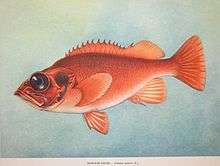Rose fish
| Rose fish | |
|---|---|
 | |
| Scientific classification | |
| Kingdom: | Animalia |
| Phylum: | Chordata |
| Class: | Actinopterygii |
| Order: | Scorpaeniformes |
| Family: | Sebastidae |
| Genus: | Sebastes |
| Species: | S. norvegicus |
| Binomial name | |
| Sebastes norvegicus (Ascanius, 1772) | |

The rose fish (Sebastes norvegicus), also known as the ocean perch,[1][2] Atlantic redfish,[3][4] Norway haddock, red perch, red bream, golden redfish, or hemdurgan, is a deep sea species of rockfish from the North Atlantic. It is a large, slow-growing, late-maturing fish and the subject of a fishery.
Taxonomy
Misleadingly, it is sometimes called bergylt, bream, or snapper, though it is unrelated to all of these. In the past, the scientific name Sebastes marinus was frequently used, but this is actually a synonym of Serranus scriba.[5]
Behaviour
This food fish lives off the coasts of northern Europe and eastern North America. Adults are found off the coast at depths of 100 to 1,000 m (330 to 3,280 ft);[6] juveniles may be found in coastal waters such as fjords. The adults are slow-moving, gregarious fish, of some commercial importance. They reach 1 m (3 ft 3 in), though most only are about half that length.[6] They are viviparous. Individuals live up to 75 years and enter reproduction rather late.[7] While the young fish are of brownish color, the adults are bright red.
The rose fish appeared on a 15-pfennig stamp of West Germany in 1964.
Fishery
One of the main fishing areas of the rose fish is the Irminger Sea between Iceland and southeastern Greenland. While annual catches during the 1980s and 90s were less than 20 kilotons, this has increased dramatically since 1999, to between 40 and 60 kilotons. In 2000, almost 80 kilotons were caught. Since then, annual catch has declined back to between 40 and 60 kilotons. The meat of this fish is almost always sold filleted, often frozen.
Since the mid-2000s, populations have been considered severely overfished.[7][8][9] According to Greenpeace, some populations are no longer reproducing sufficiently, and their chances of recovery are slim.[7] In 2010, Greenpeace International added the rose fish to its seafood red list.[10] It is also on WWF's list of fish species to avoid, unless the fishery is certified by MSC.[11][12] As of November 2016, there are no fully MSC-certified fisheries for Sebastes norvegicus.[13]
References
- ↑ food university
- ↑ ask the meat man
- ↑ RTL international
- ↑ Browne trading
- ↑ "Sebastes marinus". Integrated Taxonomic Information System. Retrieved 24 January 2006.
- 1 2 Froese, Rainer and Pauly, Daniel, eds. (2012). "Sebastes norvegicus" in FishBase. 6 2012 version.
- 1 2 3 Greenpeace: Rotbarsch
- ↑ http://www.dradio.de/dlf/sendungen/umwelt/332118/
- ↑ http://www.greenpeace.de/themen/meere/fischerei/welcher-fisch-darf-auf-den-teller
- ↑ "Red List - Seafood to avoid at the grocery store". Greenpeace International. Greenpeace. Retrieved 19 February 2016.
- ↑ "Kalaopas - Puna-ahven". WWF Finland (in Finnish). WWF Finland. Retrieved 19 February 2016.
- ↑ Kinkartz, Sabine (5 April 2014). "EU demand for fish exceeds sustainable supply". Deutsche Welle. Retrieved 8 October 2014.
- ↑ https://fisheries.msc.org/en/fisheries/@@search?q=sebastes&search=

.png)
